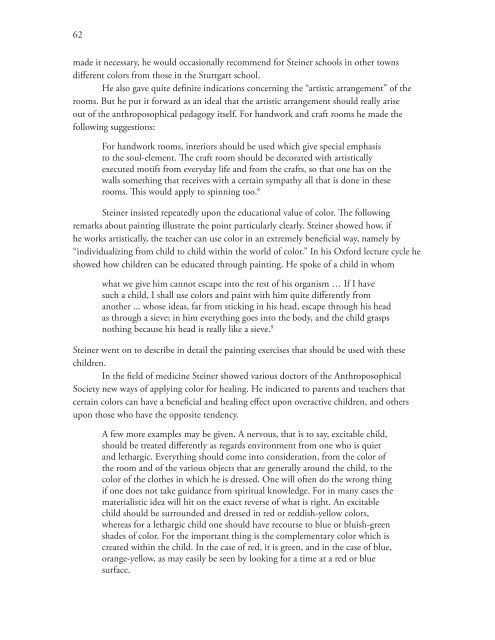Handwork and Handicrafts - Waldorf Research Institute
Handwork and Handicrafts - Waldorf Research Institute
Handwork and Handicrafts - Waldorf Research Institute
You also want an ePaper? Increase the reach of your titles
YUMPU automatically turns print PDFs into web optimized ePapers that Google loves.
62<br />
made it necessary, he would occasionally recommend for Steiner schools in other towns<br />
different colors from those in the Stuttgart school.<br />
He also gave quite definite indications concerning the “artistic arrangement” of the<br />
rooms. But he put it forward as an ideal that the artistic arrangement should really arise<br />
out of the anthroposophical pedagogy itself. For h<strong>and</strong>work <strong>and</strong> craft rooms he made the<br />
following suggestions:<br />
For h<strong>and</strong>work rooms, interiors should be used which give special emphasis<br />
to the soul-element. The craft room should be decorated with artistically<br />
executed motifs from everyday life <strong>and</strong> from the crafts, so that one has on the<br />
walls something that receives with a certain sympathy all that is done in these<br />
rooms. This would apply to spinning too. 8<br />
Steiner insisted repeatedly upon the educational value of color. The following<br />
remarks about painting illustrate the point particularly clearly. Steiner showed how, if<br />
he works artistically, the teacher can use color in an extremely beneficial way, namely by<br />
“individualizing from child to child within the world of color.” In his Oxford lecture cycle he<br />
showed how children can be educated through painting. He spoke of a child in whom<br />
what we give him cannot escape into the rest of his organism … If I have<br />
such a child, I shall use colors <strong>and</strong> paint with him quite differently from<br />
another ... whose ideas, far from sticking in his head, escape through his head<br />
as through a sieve; in him everything goes into the body, <strong>and</strong> the child grasps<br />
nothing because his head is really like a sieve. 9<br />
Steiner went on to describe in detail the painting exercises that should be used with these<br />
children.<br />
In the field of medicine Steiner showed various doctors of the Anthroposophical<br />
Society new ways of applying color for healing. He indicated to parents <strong>and</strong> teachers that<br />
certain colors can have a beneficial <strong>and</strong> healing effect upon overactive children, <strong>and</strong> others<br />
upon those who have the opposite tendency.<br />
A few more examples may be given. A nervous, that is to say, excitable child,<br />
should be treated differently as regards environment from one who is quiet<br />
<strong>and</strong> lethargic. Everything should come into consideration, from the color of<br />
the room <strong>and</strong> of the various objects that are generally around the child, to the<br />
color of the clothes in which he is dressed. One will often do the wrong thing<br />
if one does not take guidance from spiritual knowledge. For in many cases the<br />
materialistic idea will hit on the exact reverse of what is right. An excitable<br />
child should be surrounded <strong>and</strong> dressed in red or reddish-yellow colors,<br />
whereas for a lethargic child one should have recourse to blue or bluish-green<br />
shades of color. For the important thing is the complementary color which is<br />
created within the child. In the case of red, it is green, <strong>and</strong> in the case of blue,<br />
orange-yellow, as may easily be seen by looking for a time at a red or blue<br />
surface.

















